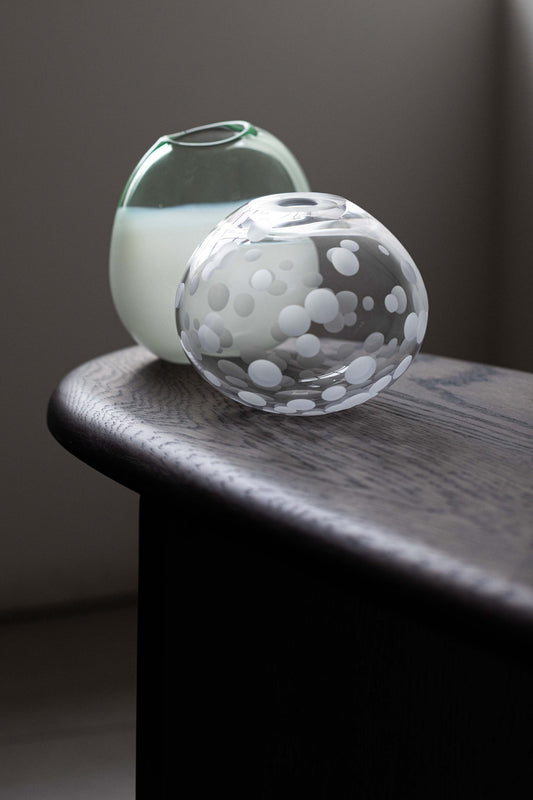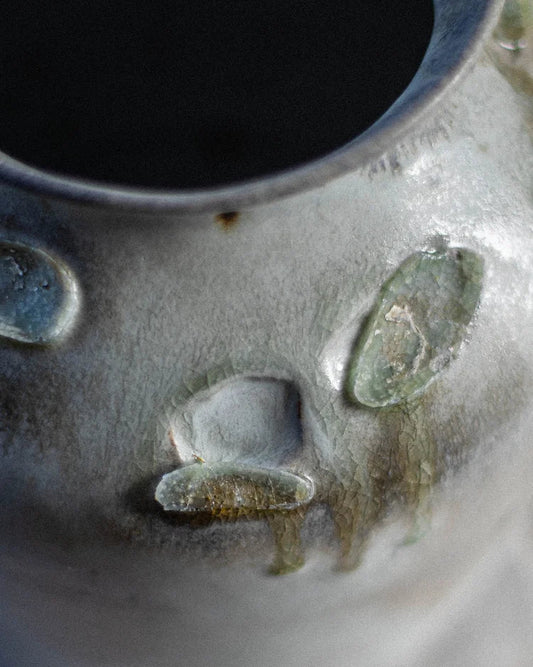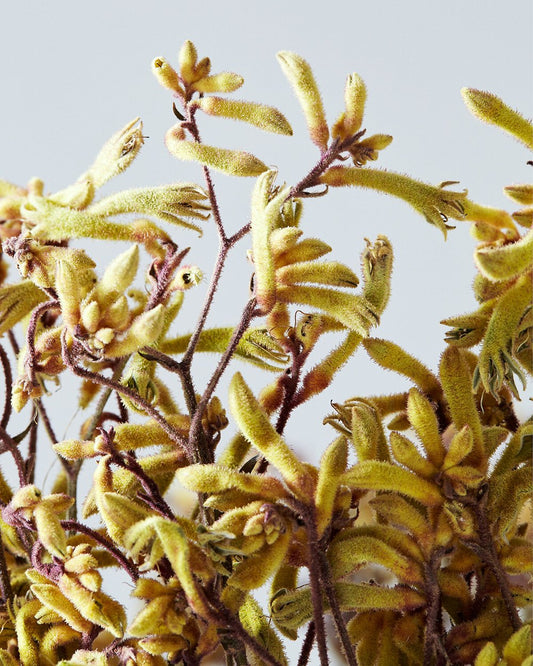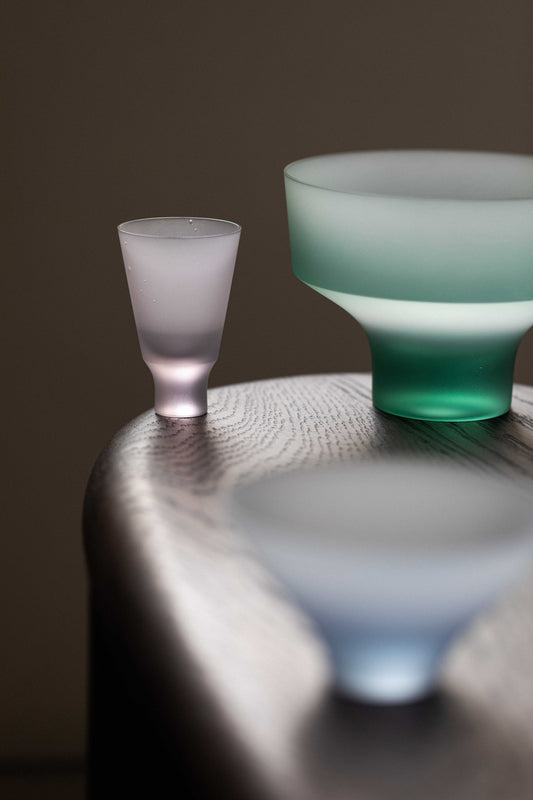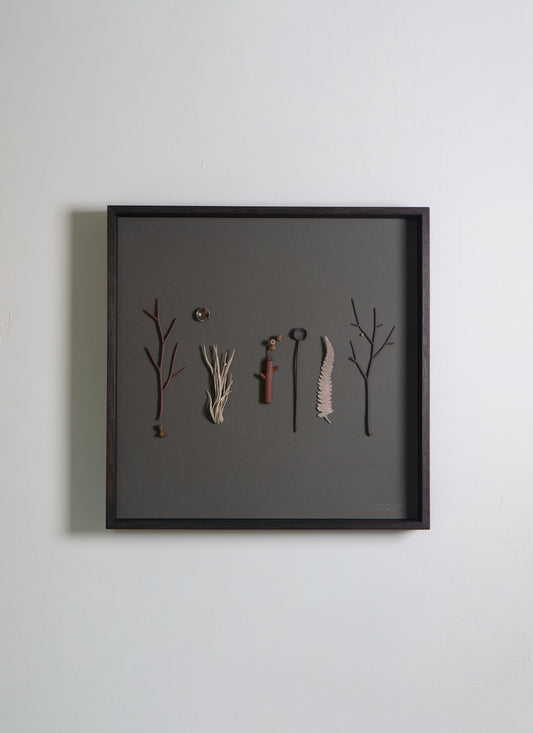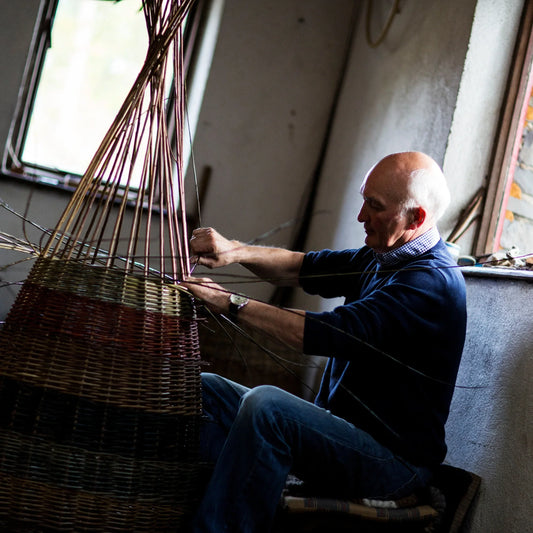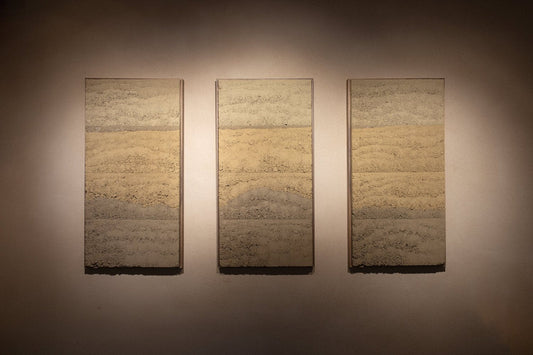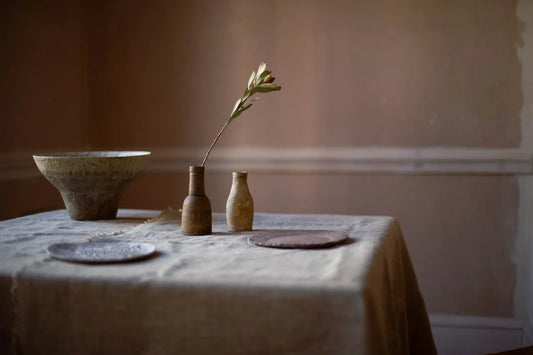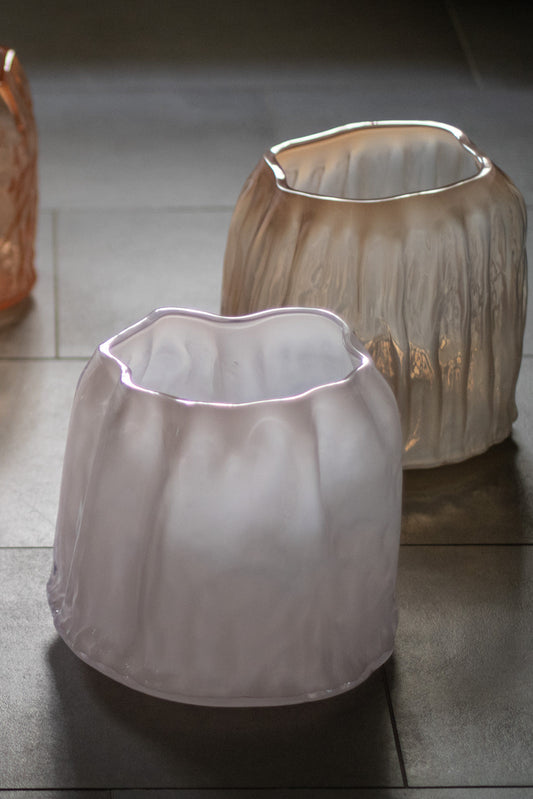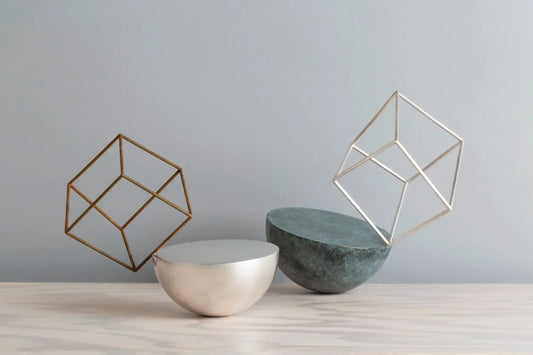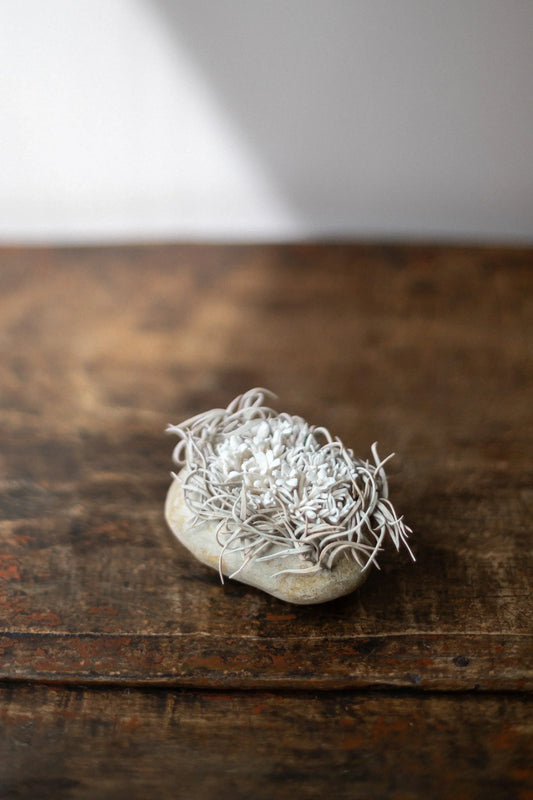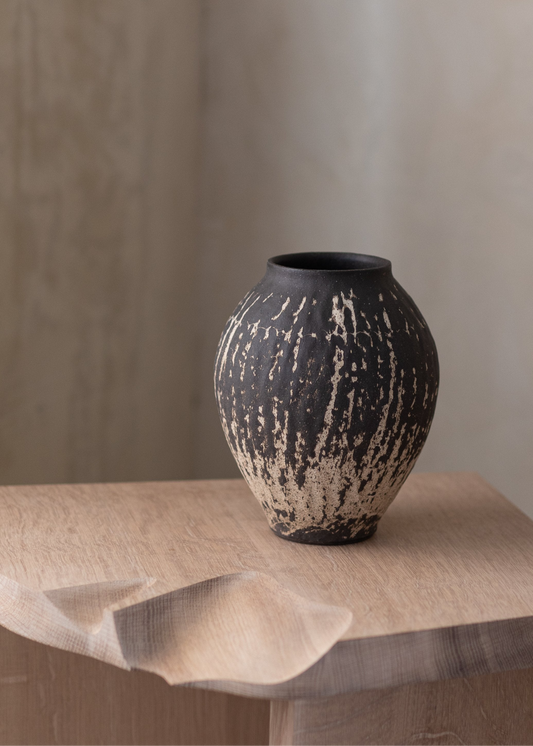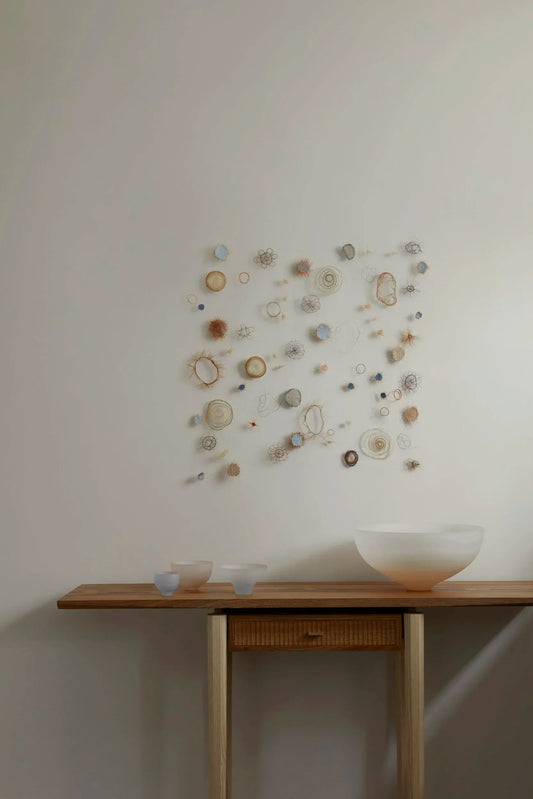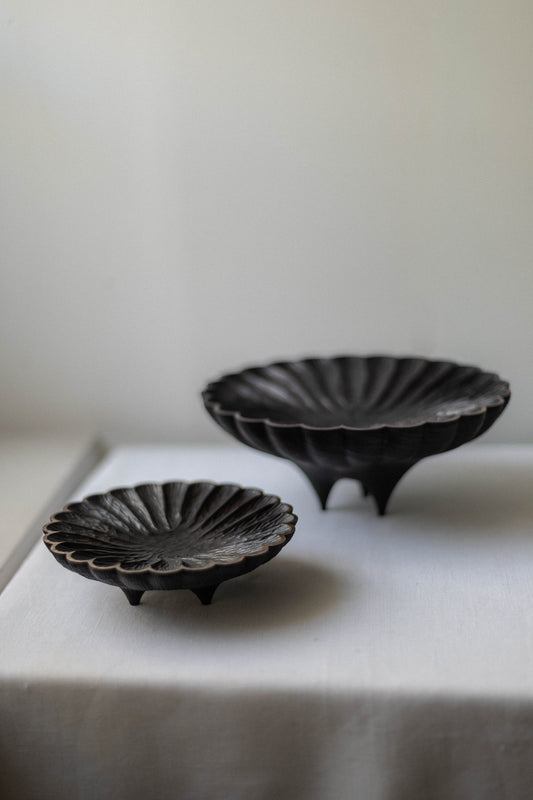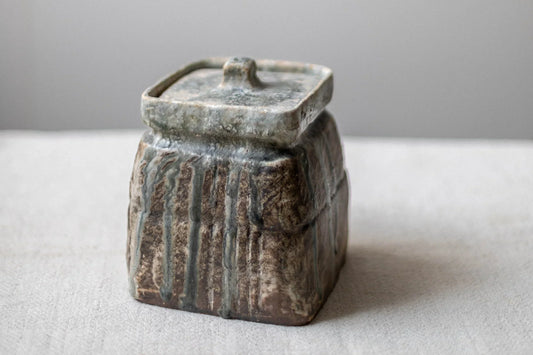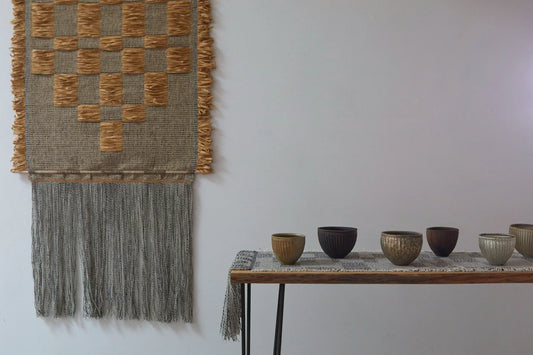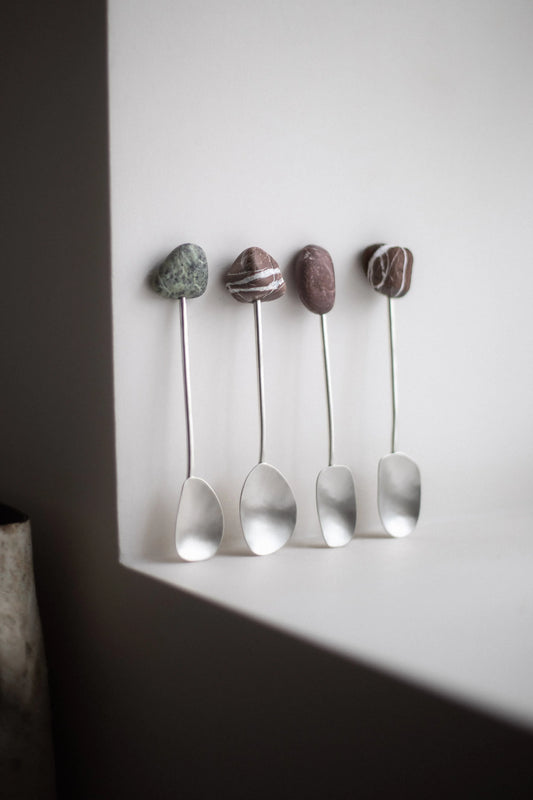STORIES & NEWS
Discover the stories behind our collaborations with our makers and other creatives.
STORIES & NEWS
Forms Through Water - New in Glass
Vezzini & Chen
Vezzini & Chen is a London-based artist duo. This collection features varying forms and patterns created through glass-blowing and carving techniques. The vessels are inspired by the experience of looking at forms through water, seeing textures & shapes shift with the depth or disturbance of the surface.
Natural Forms
Natural forms inspire Michèle Oberdieck. She explores balance and asymmetry by looking at shape, surface and colour, using the vessel as a means. A three-dimensional form becomes a gesture or expressive mark. Michèle is drawn to biomorphic shapes found in plant growth and decay such as the delicate forms tulip petals take when making this journey. These beautiful twisted organic shapes reveal the motion of ageing stopped in its tracks. It is this transformation that she aims to capture in the glass.
“I aim to capture movement & character using the fluidity of blown glass by turning away from symmetry, to recreate the organic shapes found in nature.”
Photography by Isobel Napier.
Green Hues – New Pieces in Tones of Summer
Featuring ceramics by Paul Philp, Chloé Rosetta Bell, Derek Wilson & Borja Moronta.
Glass by Michèle Oberdieck & Celia Dowson and floral sculpture by Shannon Clegg.
Chloé Rosetta Bell
Chloé Rosetta Bell's latest collection of pieces are thrown in a blend of stoneware and wild clay from the landslip below Chloé’s studio. Each is finished with two glazes. The first glaze uses crab and lobster shells which is a by-product of a local fisherman. The second is a seaweed ash glaze using seaweed from the bay below her studio. All materials are sourced by Chloé herself or a local fisherman just below her studio.
Paul Philp
Paul Philp has been making ceramics for over 50 years. His ceramics are hand-built and fired multiple times. Thin layers of slip, organic material and glaze build and strip away to reveal a subtle yet intricate depth in his surfaces. His influences include Japanese MinKa building, architecture, tribal and ancient art, but above all, the natural world.
Borja Moronta
Moss Green and Mist Blue Glaze
Each stage of Borja Moronta’s process leads to humble ceramic pieces that condense his upbringing on the northern Spanish coast; its colours, textures and pace. He aims to create calm and neutral minimalistic objects and compositions, following simple forms in a soft tone palette hoping to alleviate the eye.
Michèle Oberdieck
Michèle Oberdieck is drawn to biomorphic shapes found in plant growth and decay such as the delicate forms tulip petals take when making this journey. These beautiful twisted organic shapes reveal the motion of ageing stopped in its tracks. It is this transformation that she aims to capture in the glass.
“I aim to capture movement & character using the fluidity of blown glass by turning away from symmetry, in an attempt to recreate the organic shapes found in nature."
- Michèle Oberdieck
New Showcase - ‘Sculpting Nature’ by Shannon Clegg
This May and June, Shannon Clegg’s botanical sculptures are blooming at Flow Gallery. Reimagining the traditional art of pressing flowers in three-dimensional form, her designs are made from a delicate lattice of stems that enable the flowers to stand unfettered by a vase.
“For me making is more than just producing; it's a way to re-engage with the natural world. Innovating traditional craft practices, like flower pressing, goes beyond methods; it's about modernising our heritage and fostering sustainability.”
- Shannon Clegg
Shannon Clegg creates botanical sculptures using a unique hand-moulding technique and fresh-cut flowers, such as Statice and Kangaroo Paw. Working from fresh rather than dried flowers, she reimagines the traditional craft process of flower pressing: her three-dimensional, sculptural interpretation preserves the dynamism of flowers growing in nature.
Her flower sculptures look to biophilic design, which reflects the human desire to connect with nature in the built environment for well-being reasons by integrating natural elements into one’s interior space. Through the utilisation and reimagining of traditional craft skills, her practice investigates the narrative potential of making to encourage a better human-nature relationship.
The technique she uses is therefore entirely innovative. To develop the process, she based her research at The Herbarium at The Royal Botanic Gardens at Kew, looking through archival methods for storing pressed flowers and equipment used by botanists to collect flowers from around the world.
Investigating the mould-making of other crafts such as ceramic and millinery, she then created her own technique to form and press real plant material to create vase-like sculptures. The technique involves hand-making moulds that are used to shape the plant material over several weeks after which they are preserved to help retain the flower’s colour and shape.
Shannon’s collection made specially for Flow Gallery uses seasonal flowers that she hand-selects at flower markets, and her flowers are sourced both locally and abroad. The pieces in this showcase use Kangaroo Paw, Lavender and Statice, which are all flowers that Shannon favours for their strength and textural richness. The combination of their natural structural qualities and Shannon’s preservation techniques enable to flowers to stand upright, as if freshly picked or even still growing from the earth. In this way, she not only preserves the flowers’ botany, but the essence of flowers in bloom.
About Shannon Clegg
South African-born Shannon Clegg is a designer-maker based in East London who looks to innovate traditional craft processes to create objects that connect people to nature. She grew up amongst the flora of Table Mountain in Cape Town, South Africa where she trained as a tailor. After a brief stint in fashion, she realised she had “issues with the ethics of production in the industry” so packed her bags for London, hoping to discover different contexts for making. She went on to study BA in Contemporary Crafts at Falmouth University in Cornwall and MA in Product and Furniture Design at Kingston University in London.
Changing Light – New Glass by Celia Dowson
Informed by movements in nature, Celia’s work reflects the colours, the changing light, and mystery of the natural world.
The finished pieces encompass the study of colour and translucency through gradation and opacity and light. Through these qualities her work creates a contemplative space to reflect upon the rhythms of the atmosphere, and our innate connection to the objects we use and spaces we inhabit.
Celia is pleased to share these new drinking glasses, forms made through observation of water; inspiration gathered during quiet walks along the foreshore of the River Thames.
“It’s a peaceful place and I was drawn in by the softness of the water and its ability to absorb light resulting in a spectrum of colours that glow across its surface, textured by the pull of the tide…these pieces reflect the clarity of clear, deep grey blues on a darker day and evening light, glow, pink.”
The glass is left satin, with only the rim and base polished so you can see into the depth of the glass, its molten textures and the clarity of the glass.
About Celia Dowson
Celia Dowson ’s glass pieces go beyond the classical concepts of function, quietly offering moments for reflection and contemplation. Made using kiln casting techniques, the pieces are cast for several days allowing the glass to fold and melt into the mould, capturing bubbles in its depth. While this process creates fluidity and movement in the pieces, the modelling and finishing processes are always very controlled with precise carving, sanding and polishing stages.
“The forms I make are symmetrical and there needs to be real clarity in the surface finish. Models are made with varying thicknesses. Glass pools into these shapes, creating subtle changes in colour. Light interacts with polished and satin surfaces, reflecting and refracting in beautiful ways.”
- Celia Dowson
Artwork Photography by Isobel Napier
Celia Dowson Portraits by Emma Dudlyke
IN THREES
The Rule of Three is a principle in literature, suggesting that a trio of entities holds a unique potency. Authors employ this technique in storytelling, crafting triplets or structures divided into three parts. At its essence lies the simplicity of beginning, middle, and end.
Blending brevity with rhythm to create a pattern with the minimal amount of information, this can create tension, energy, and intrigue. Reflecting on this concept through photography, we explore pieces from Flow's collection, in threes.
JEAJUN LEE | CELIA DOWSON
Flared Vessels
YUTA SEGAWA | CELIA DOWSON
Miniature Vessels
YUTA SEGAWA | SUE PARASKEVA
Porcelain Vessels
MASAMICHI YOSHIKAWA | JAEJUN LEE
Celadon Vessels
JAEJUN LEE |
Grey Vessels
CELIA DOWSON |
Seascape Vessels
Photography by Isobel Napier
Abigail Schama – A Studio Visit
Abigail Schama welcomed Flow’s Alina Young and Isobel Napier into her North-West London studio; a lively creative space that Schama co-founded, where resident ceramicists are joined by a photographer, a writer and evening class students. Schama’s ceramic works from past exhibitions are displayed across the studio – an environment she calls her “sketchbook”. She sits down with Alina Young to discuss her approach to making and her intuitive process.
Since she began working with clay, Schama has been drawn to functional forms. Schama chooses to create vessels for their connection to domesticity – as commonplace objects, bowls, jugs or vases carry immediate associations that she enjoys playing with:
“From my first pieces, there was a discussion about functionality and non-functionality. I’ve always worked with vessels because the starting point is familiarity; then, you can move away from it in a way that challenges people. You can only challenge if you start with what people know, and what they know is – jug, bowl, plate. And then – it’s still a jug – it absolutely functions, but it’s dancing. She would still do the job, but I’m teasing a little bit, playing with your expectations and what you’re comfortable with. Comfort is the opposite of art.”
The bodies of her vessels become her canvas for textured, highly expressive surfaces. Schama first trained as a fine art painter, which continues to inspire her.
“I can’t help it – I love painting. I am not satisfied with just a perfect skin that’s flat, it won’t necessarily do it for me. So, I will keep trying to eke out something, as though I was painting it. Even when I was painting, I was uncovering rather than covering. So I still approach it that way.”
There is no set tool, glaze or technique that Schama uses to achieve these effects. “I’ll use anything,” she explains:
“I’m quite relaxed to be playful, see what happens. I’m not a chemically-minded or calculated kind of maker, and I don’t really want to be because I like the element of surprise. I like to see how something really did work on some pots, whilst on others it didn’t – so I’ll pick it up again and make it happen. In terms of colour, paint, and mark-making, I’m persistent. But also the beauty of ceramics is that you have to surrender if something doesn’t work.”
The element of surprise also applies to the clay body. Schama regularly throws with a reclaimed clay mixture, composed of an unknown combination of clays that she and the studio’s other makers are using – including stoneware, porcelain, terracotta, black and red clays. The complexion of each piece therefore represents a snapshot of a period in time, remaining unpredictable and unique.
“I’ve been using the reclaimed clay since we moved in. It’s often thrown away, so once we opened this studio I resolved to make it my business to reclaim and use it. I want to show how it’s not rubbish or redundant. There are many challenges with it; it took me time to figure out that, due to the different clays and whatever impurities are in it, you have to fire at a much lower temperature than you expect so that it doesn’t blister. The second thing is the colour – when you throw with it, it’s the most spectacular pink, but generally comes out sandy. But even when I’m not using the reclaimed clay, I never use just straight up stoneware on its own. I use black, I use red, I use grey. I go between them intuitively.”
The diverse results of her experimentation gives enormous individuality to each pot; her studio’s display showcases how her work is a continuous series that sees her return to re-experiment with forms and surfaces. She comments on having her previous pieces around her whilst she works:
“It's like my sketchbook. I think: “How did I get that spout like that piece over there?” and it informs a new pot.” Or even sometimes what went wrong. I keep these notes in my head, and whilst I don’t always get it right, it’s more meaningful to me.”
Lining one wall in her studio are Schama’s art books, expressing the diverse interests that she often “dips around”, such as Rembrandt, Cy Twombly and Pierro della Francesca. In a similar way, she collects inspirations from life in her sketchbook:
“I write, rather than draw and map out pieces. When I’m making, I like to follow the material and follow the narrative of its context in my head. The context of what I’ve absorbed. I write a lot to myself about things I've noticed – something in a film, from walking down the street. I heard a harpist play the other night, and was inspired by the lines on her instrument and the way she sat, her posture. I make notes on my lived experience. That's my sketchbook. It’s become more important to my process, because I realised that the more I make and the more I write, the more I can find the nugget I’m looking for and try and tell the truth.”
Finding a “truth” or “integrity” in her expression is important for Schama. She ties this closely to theories of psychoanalysis, being drawn to the “truths” of interpersonal interactions and how this translates to her pots.
“I could say, "How are you?" and you could answer "I'm fine"; or you can really tell me what's going on. In a similar way, I can show you an image of one of my pots and there you can see it's skeleton, but you can't really see its experience. At that point, the jug or bowl is just a motif, and it’s starting with what’s familiar; like in psychonanalysis, how it’s easy to say “How are you?”, it’s easy to say “this is a jug”. But I'm interested in interiority, and how the only way that you can communicate interiority is by showing the external.”
It’s through this interest that Schama explains she often makes “counter piece” to her pots – as in psychoanalysis, “it reminds me of two sides of person, the exterior and the interior side.” In these doubles, one pot may present an individual’s outward-facing personality, whilst the other imagines a hidden interior.
When her pots are displayed together, they too become engaged in interactions: “I'm interested in conversation, in communication, in the act of listening. I did a show called "Listening Devices ", where pieces were leaning towards each other and craning in, as if listening.” This animates her pots, who seem to express individuality through anthropormophic behaviours.
Conversations between personalities is something Schama is drawn to in daily life, too. “I think community is a really valuable resource for creativity.”
She finds the experience of working with others is highly generative to development:
“When teaching, you are being asked to do something for someone else or being asked to do it because that's their idea, and this can be really illuminating. You're not looking for answers, you’re just offering how "you could do it like this". When I have people sitting next to me on the wheel, we do that during the day, too; I don't really want to demonstrate, but you're welcome to watch me. Sometimes it’s when you’re demonstrating something that you suddenly think “I'm going to do that tomorrow. I haven't thought of that yet.”
Interview and text by Alina YoungStudio Photography by Isobel Napier
TEA-WARE | Pieces for a Tactile Process
Each piece of this collection by Tamotsu Suzuki is made from a red clay with a “kohiki’ style slip. The textural quality of this surface makes for a tactile, tranquil process. Paired here with a bowl in Walnut, by French wood artist Etienne Bailleul, and gold plated spoon by Japanese jeweller, Kei Tominaga.
Based in Yamanashi on the island of Honshu, southwest of Tokyo, Suzuki studied at the Tokyo University of the Arts. Inspired by plants that live powerfully in nature, his work is reminiscent of organic plant forms and textures.
“All my work is hand built, showing the traces of my fingers. I am in awe of plants with delicate & tough forms. I feel them at our fingertips.”
- Tamotsu Suzuki
Sculptor and designer Etienne Bailleul has a similar reverence for nature. Living and working in Lower Normandy, France, Bailleul’s fascination with plant forms inspires the design of his work, exploring the softness of organic lines and a sense of growth. His pieces unify function with sculptural beauty, becoming deeply expressive meditations on nature.
“I use powerful and delicate shapes to express the beauty and the fragility of nature. I’m mostly inspired by plants – simple organisms that are extremely durable and resilient.”
- Etienne Bailleul
Wall Pieces by Elaine Sheppard Bolt
Developing her interest in capturing the landscape of the South Downs in porcelain, Elaine Sheppard Bolt’s new wall pieces present delicately modelled plants in calming compositions.
Sheppard Bolt creates wall pieces featuring ceramic and mixed media compositions that blur the boundaries between the made and the found. Some works incorporate nature-inspired pieces alongside domestic motifs such as household utensils; further exploring the interaction between made objects and the natural world.
“Finished in a muted colour palette, all of these works are informed by colours and tones found in the landscape of the South Downs; featuring deep flint blacks, through soft grey stony glazes to ghostly chalk tones.”
- Elaine Sheppard Bolt
These compositions are often displayed in formats that reference museum or botanical collections, and are inspired by objects and places observed on walks in the woodland and shoreline of the Sussex landscape.
Her newest pieces combine porcelain, with oxides, twigs, lichen, acorns and wire, and have been mounted on board within a specially made stained and waxed beech frame.
Joe Hogan – On Making Nests
Ahead of Flow’s 2024 solo show with Irish basketmaker Joe Hogan, he shares his writing on “Nests”, a dimension of his practice that he has been exploring since 2012.
Nests – An Introduction
by Joe Hogan
I have been making nests now since about 2012. These started small but in the last few years, I have tried to expand the size to include nests of larger birds. The aim has not been to make copies of the nests of various species of birds but rather to make nest-like objects which prompt the feeling that we are looking at a bird's nest and thus evoke some of the feelings of joy and wonder which might accompany the finding of nests in the wild. The nests have an artlessness to them as I do not want it to be obvious that they have been made by a person. They celebrate the lives of birds and also explore what it means to be “at home in the world”.
This nest-making was prompted by a number of things. One was my belief that many of us have lost our natural sense of what it means to be at home here in this world. We have lost the feeling that we too are part of nature. The lack of this feeling of belonging may explain our failure to properly address the ecological problems we face as a species. I wanted to make objects that might, in some vague way, rekindle our connection with the world of twigs and stones and remind us of the joyful surprise we might feel when we encounter nature's abundance. Rachel Carson remarked that the greatest gift we can give a child is the gift of “a sense of wonder” and hoped it would be “so indestructible that it would last throughout life”. In the essayMossbawn Seamus Heaney remarks: “All children want to crouch into their secret nests....I spent time in the throat of an old willow tree...once you squeezed through it you were at the heart of a different life.” But many of us lose this childlike capacity to see the world with wondrous eyes.
The project also seeks to highlight the shocking collapse in bird numbers over the last 20 years and the general loss of bio-diversity that has helped to cause this decline, especially the loss of habitat and the decline of insect life. Our attitude to insects often seems to revolve around how to kill them rather than celebrating them. It is easy to forget how essential insects are for pollination and for helping the process of decomposition.
Making Nests
by Joe Hogan
About sixty years ago, Mao Tse Tung had what he thought was a flash of insight. If the sparrows could be prevented from eating grain then there would be more left for the people to eat. And so began a period of persecution for the sparrows. The level of obedience in China at the time was so great that most of the population joined in the campaign. They used drums to prevent sparrows from landing. As soon as a sparrow stopped to rest they were hunted away and many of them simply died of exhaustion. Millions of sparrows died and they became close to extinction in China… Did this lead to more grain for the people? Not exactly. Instead, there was a plague of locusts the following year. The locusts had lost their main predator. Grain production collapsed over the next two years and there was a huge famine. Official figures put the death toll of that famine at 17 million people but it is estimated by most experts that the death toll was at least 45 million people. Moreover in order to eradicate the locusts poisonous chemicals were used with the result that many beneficial insects were killed. Some crops had to be hand-pollinated.
This story illustrates the inter-connectedness of all living things, the discipline now known as ecology. Long before the word ecology was ever heard of, Chief Seattle spoke about the “great web” and how important it was that we understand that “we did not make the great web, we are merely a strand in it”.
The UN has recently warned of a catastrophic loss of biodiversity with the loss of insect populations being particularly marked. It is very easy to overlook the importance of insects, their role in pollination, in breaking down all natural materials back into the soil and of course as food for birds. There has also been a dramatic decrease in the number of birds over the skies of Europe and north America over the last 30 years.
And so this project is for me a way to explore and educate myself about biodiversity loss. But this is only one of the strands woven into it. It is also a way to explore what it means to be at home in the world. One of the seed ideas that started this project was an image from Mary Oliver's poem, Wild Geese where she talks about the world “offering itself to our imagination”, calling to us like the wild geese, reminding each one of us of our place in the “ family of things”.
Other images fed this desire to make nests such as Wendell Berry's “the peace of wild things” and Yeat's lines (even though not about a bird's nest) that “the mountain grass does not forget where the mountain hare has lain”. Inspiration also came from the wonderful imagery of birds that runs through Eamon Grennan's poems.
But of course, it also comes back to making. To exploring materials, what they will or will not do. The materials suggest possibilities, other ideas arise. With these nests I am trying to make things that do not show the way they are made – that seem almost artless. Past experience using heather to make lobster pots helps and leads to other materials, birch, larch, lichen.
Ideas arise again. What is it to be at home? What is it like to be homeless? A cardboard box and a sleeping bag as a human nest. Another type of homelessness is to be cast out from your own place in the world, a migrant in a world obsessed with borders. Amongst the graffiti in the “jungle” near Calais, a phrase, “we borrow the hearts of the migratory birds who do not trouble themselves with borders.” What chance that we could learn from the birds and realise the connections that bind us?
Makers & Museums Trip to Korea 2023
15th - 27th October 2023
Flow’s Gallery Director Yvonna Demczynska together with cultural voyager Cathy Giangrande led a group across South Korea to discover the richness and diversity of Korean crafts, past and present. The tour discovered the revered galleries of Seoul and the ceramic village of Icheon, travelled south to the tea fields of Gwangju, the Gangjin Celadons and the Mokpo Marine Relics, and took in the scenic temples and national parks of Gyeongju – to name but a few of the sights. At every corner, they visited internationally acclaimed as well as emerging artists in their studios, receiving talks directly from the makers about their practice. The tour included visits to the key galleries and museums, as well as some lesser known institutions, with specially organised talks by leading Korean curators.
To remember the trip, those who took part in the tour have kindly offered some words and photos about their experiences.
“Yet again, Flow Gallery’s Yvonna Demczynska, and her partner on these tours, the cultural voyager, Cathy Giangrande, delivered an outstanding and inspirational trip – visits to the most extraordinary craftspeople at work in their studios, museum visits and talks from curators displaying astounding artefacts- visits the length and breadth of the country peppered with extraordinary dining experiences -sometimes from the sublime ( Michelin star restaurants) to the (not quite ridiculous but verging) - Korean fried chicken meal set in a car museum in Gyeongju ( personally I loved those fries and cheese balls!). Counterbalancing the cultural history -the blasting music from the night clubs and singing bars in Gwangju – yes I am ashamed to admit I was keen to try those microphones! The camaraderie of the tour group on bus and train journeys – joyful full of chat and laughter with a good dose of K pop education thrown in courtesy of one of the group. Truly an insight into the artists and the arts and crafts, the history and culture, and food of South Korea – a relatively young country, given its history, forging its way forwarding with modernism, whilst maintaining its long standing cultural traditions.
I loved every moment of it, and the whole experience will stay with me for years to come as a highlight of life experience I am lucky enough to have had. Truly food for the soul/Seoul.
Kam-sa-ham-ni-da”
Ruth Young
“It was such a privilege to meet the amazing South Korean Makers during our recent visit with Yvonna and Cathy. One would never normally have the opportunity to visit their homes and studios. The meticulous planning and insight of the Makers and Museums Tours are truly remarkable”
Margaret Pope
Having returned recently from an action packed trip to Korea, I am still immersed in my photos and memories. Korea is a country of exquisite detail. They of course have had centuries to master this, but having seen relics from the bottom of the Yellow Sea that have been sitting there since the 7th Century, it seems to have been a well kept secret.
The trip was a master plan in organisation. We were ferried around in great comfort to see Master potters, Delicate textiles, Secret museums, Traditional houses, ate in many special eateries trying all sorts of delicacies. And to top it all we were kept amused with tales of Korea past and present, and how the country having overcome so many invasions from its neighbours, is becoming the new power house of Asia. Trip of a Lifetime.
Marlene Mackibbin
Besides visiting in artisans’ studios the Makers & Museums tour had a chance to explore some of South Korea’s outstanding cultural venues. Among them was the National Research Institute of Maritime Cultural Heritage located in Mokpo on the west coast of the country. Over four galleries we learned about the maritime exchanges of the past, through models of shipwrecks and various types of ceramics discovered in the seas of Korea. Among these were the remains of the Sinan shipwreck, a merchant vessel leaving China in 1323 carrying 25,000 pieces of Chinese export wares, Goryeo celadon and other items including spices consider more valuable than gold. Wrecked off the coast of Korea near the Sinan islands it was discovered by fisherman in 1975.
Additionally, the conservation scientist, Young-Hwa Jung took us to the conservation facilities to see how ship remains are being conserved prior to display. Placed in large vats of water to remove the salts, the ship timbers are then impregnated with PEG – polyethylene glycol, a wax-like substance that supports the collapsed cell structure of the wood. It was an illuminating visit that certainly ignited our imaginations.
Trip Co-Organiser, Cathy Giangrande
Visit to Cornwall – ‘Claymoon’
Yvonna Demczynska, Flow Gallery’s Director, was invited to visit the Cornwall studio of Adam Weismann & Studio for the launch of their new wall artwork series – ‘Claymoon’.
The artworks were spread across three locations: the specially designed ‘Moon House’ viewing space in Adam Weismann’s gardens, the James Turrell Skyspace at the Tremenheere Sculpture Gardens, and the Gallery at the Sculpture Gardens. Weismann generously welcomed the guests, and the events were organised by Margaret PR studio.
The ‘Moon House’ was designed as a meditative space for contemplation of the artworks, creating an intimate and calming setting within a natural environment. This innovative approach to art installation created an immersive experience that linked the artworks to the surrounding Cornish landscape.
The studio explains how the series has ‘been created with the intention of being meditative, contemplative, raw and elemental – inviting the viewer to find a state of ‘soft fascination’.’ To enhance this effect, the panels are sometimes created in triptychs, with a visual rise and fall that is reminiscent of the ebb and flow of the tide, or the inhale and exhale of breath.
The artworks have been made in Cornwall from local raw materials. This passively connects the artworks to the environment and space in which they are shown.
The Claymoon series are hand-formed, unfired clay wall panels, that ‘speak to the rhythms of nature and to our connection with the natural world,’ Weismann and his studio explain. Made using vernacular building techniques such as ‘rammed earth’, earth plasters – encased in brass and walnut frames, the monolithic forms feature muted tones using earth pigments.
In the James Turrell Skyspace, the Claymoon panels have been installed in an architecturally immersive “artwork” by American artist James Turrell. The skyspace integrates the changing sky into the installation, creating a sublime elemental connection between the Claymoon panels and the outside space.
Claymoon pieces were on display at the Gallery at the Tremenheere Sculpture Gardens, giving an additional context for how the series can be curated and viewed. The group were also hosted for dinner at the Gallery, using locally sourced produce for the meal.
Yvonna was delighted to have been invited to learn about the pieces in such inspiring contexts, that allowed her to experience the landscapes that inspired ‘Claymoon’. She is grateful to Adam Weismann, his studio and the wider team for the opportunity.
Incremental Layers | Flow at Mare Street
Photography project at 195 Mare Street, Hackney, featuring pieces from our collection that engage withsurface texture and the idea of layers and history .
“I have in mind rugged eroded surfaces, megaliths, fossils, ancient encrusted marbles.”
- Paul Philp
Built in 1697 as a grand country house, 195 Mare Street is one of Hackney's oldest buildings. Home to the Elizabeth Fry Refuge between 1860 and 1930, the property housed thousands of young women recently released from prison. In the twentieth century, it became the New Lansdowne Working Men’s Club before falling into disrepair. It is soon to be restored as a family home and community arts venue. New owners, Elizabeth and her family, generously welcomed our objects into the space before renovation.
“My work explores the redundancy and renewal of an object, connecting the past with the present. The evidence of the passing of time - frayed fabric, peeling paint, eroded architecture, rusting metals, decay and erosion, inspires me.”
- Lisa Stockham
In anticipation of this photoshoot, we became preoccupied with ideas oftexture . We wanted to bring together works that complimented the rich surfaces of 195 Mare Street.
The processes of each
Abigail Schama’s pieces are wheel thrown from different combinations of dark and light clay bodies, which recently has included reclaimed clays from her shared studio. The recycled clay is composed of an unpredictable combination of what her and other makers are using – stoneware, porcelain, terracotta, black or red clays – and so the complexion of each piece represents a snapshot of a period in time , in the same way as the revealing of centuries of wallpapers.
Lisa Stockham’s pieces are reminiscent of cut sheets of fabric and similarly feel as if the form has been rebuilt from fragments .
The process of repetition is important to silversmith Francisca Onumah, who works from sheet metal obsessively layering different mark-making techniques, folding and impressing patterns onto the surface of the metal.
Similarly, Paul Philp’s stoneware surfaces are treated variously with incremental layers of oxides, wood ash glaze and slip, through multiple high-temperature firings, giving them the highly-textured, sometimes encrusted, appearance of relics.
These various making processes relate to the strata of materials formed over centuries at Mare Street.
“The body and form of clay is another surface for making marks and cultivating textures.”
- Abigail Schama
It was such a pleasure to hear about the history of the building from Elizabeth and their plans for its future. We look forward to seeing how it evolves.
29th September - 8th October 2023
195 Mare Street’s last exhibition before their restoration project begins, is on now.
Photography & styling by James Trundle & Isobel Napier
A new collection by Bubun From Japan
Introducing Bubun Jewellery by Megumi Jin and Nobuyuki Jin, a collection of woven glass jewellery from Japan. This exquisite collection features pieces crafted with borosilicate glass, polythene thread, & 18k yellow gold, blending beauty with craftsmanship.
“Glass visually blurs the boundary between the body and its environment connecting them. Each piece is formed of glass woven by thread reinforcing the relationship between the jewellery, our bodies and the surrounding environment.”
Discover Summer Glass
Welcome the summer with vibrant glass at Flow, from flower vases to delicate sculptures. All selected pieces are currently available, explore the range below
“Through smooth surfaces and refined colour nuances, my vessels express softness & balance. Where elements of the making are left to chance, the creative process is echoed & embedded in each piece.” – Celia Dowson
“I aim to capture movement & character using the fluidity of blown glass by turning away from symmetry, in an attempt to recreate the organic shapes found in nature.” – Michèle Oberdieck
“Edmond Byrne’s new glass vessels carry marks that reflect the moment of their making and their yearning for the past. Here is a balance of the ancient and the present; the remembered and the contemporary. They have an empathy with nature as well as time. Chance and order both have a role to play in the working of the glass and the scrupulous setting out of the final ‘still-life’ tableaux.” – Professor Simon Olding, writing on Edmond Byrne
“My passion is blown glass formed by hand into vessels or flat panels. My work is richly decorated, bordering on baroque. I seek to capture the sensual element in glass. Nature is constantly present” – Ulla Forsell
Trine Drisvholm's glass sculptures are featured in our current exhibition, 'Constructing Space', which presents three Danish artists working in glass, porcelain and metal.
An Exhibition of Danish Craft
Flow Gallery x London Craft Week
Supported by the Danish Arts Foundation and the Embassy of Denmark in London
Opening as part of London Craft Week, Flow Gallery’s new show ‘Constructing Space’ exhibits three Danish artists: Ane Christensen, Heidi Hentze & Trine Drivsholm.Discover more about the exhibition below, including interviews with the artists.
An Introduction from Gallery Director, Yvonna Demczynska:
In ‘Constructing Space’, we present three female Danish artists, Ane Christensen, Heidi Hentze and Trine Drivsholm. Through their different materials – metal, porcelain, and glass – the artists give a lens into the amazing diversity of contemporary Danish craft.
Their work has never been shown together before, yet Christensen, Hentze and Drivsholm are of the same generation, and are all at an exciting mid-career stage – each show a mature practice and mastery of their materials, yet are still driven by experimentation and evolution.
Developing the exhibition, the Flow team were inspired by how the artists’ different mediums invite contrast and comparison, whilst communicating in a similar visual language. We hope that by bringing these works together, visitors will be encouraged to contemplate how shared concepts and themes are explored in beautifully distinct ways.
The phrase ‘Constructing Space’ refers to the artists’ ability to manipulate their materials and create the feeling of forms being continuously constructed and deconstructed. Ane Christensen, for instance, describes her work as “line drawing in space”, where material defies gravity. Each artist pushes the possibilities of form versus absence, exploring negative space and the interaction between light and shadow. Air and light, therefore, become ephemeral “materials” across all the artists’ work.
Thematically, all the artists also present an interpretation of geometry – whether mathematical or organic. Geometric forms emphasise a sense of ‘structure’, creating visual interest through shape, angles and a sense of balance. In their own ways, the artists enhance these spatial elements through the unique qualities of their mediums. Interpretations of balance and fragility are further emphasised through the objects’ lack of conventional function. In itself, this challenges viewers’ preconceptions of the purpose of craft and highlights the sculptural element inherent in the exhibition’s pieces. Together, their diverse artistic practices become poetic and quietly subversive explorations of the interactions between material and space.
Meet the Makers
Ane Christensen – Metal
“I always try and capture the fluid, loose energy of line drawing in my work, in the third dimension… I want my work to have a sense of lightness and effortlessness”
Ane Christensen’s work in metal transforms familiar, functional forms, quietly contemplating how a simple shape like a bowl can become a visually complex, open and delicate structure. Beginning with flat sheets of metal, Christensen applies traditional techniques like hand piercing, drilling and soldering to construct her pieces. The combination of varied metals furthers her exploration of colour and texture, deepening the viewers’ experience of shapes.
Using geometry as a starting point, Christensen departs from the original form whilst leaving enough of it to still be recognisable, as in her ‘Ghost Bowls’. For her, “The geometric element is important as it serves as a contrast to more random or chaotic elements in the final work.” Yet, the immensely controlled making process and formal qualities of each piece’s structure are counter-balanced by shadow – the unpredictable, constantly evolving element of her work. She describes how “I sometimes construct shadows in metal as a way to capture them and make them part of a piece. I hand-draw each shadow before piercing them out of sheet metal. Winter is the best time for drawing as the low sun creates beautifully dramatic and distorted shadows.”
“Every piece I make is a meeting of contrasting elements within a form. The meeting point and tension between elements such as dark & light, heavy & delicate, solid & open or soft & sharp is the essence of my practice. I am never looking to create perfect balance within my work. I find pieces which are slightly awkward or off-balance more engaging and relevant.”
The mysterious meeting point between form and absence, structure and shadow, creates a sense of illusion. Each piece therefore playfully challenges perception: “My work often appears weightless or as if floating, although it is in fact very heavy or precariously balanced whilst quite sturdy. I use illusion to add visual movement to my work.”
Photography by Nicola Tree and Paul Reed
Heidi Hentze – Porcelain
“My hope is that these new Architectonic pieces will present the viewer with a bit of an "it reminds me of..." feeling, and simultaneously with a curiosity into how they were constructed.”
Heidi Hentze investigates porcelain and glaze in poetically folded pieces. Based on inspiration from architecture andKirigami , her ‘Architectonics’ collection for this exhibition challenges our perceptions of material, gravity, and classic slab techniques. Meticulously assembling paper-thin clay constructions, Hentze applies an extraordinary level of skill to slab-building – “a very precise and time-consuming process, in which I challenge the boundaries of how thin my porcelain can be without breaking.” It is a process of precision, accident and experimentation.
“It is often the mishaps that open up new paths in my work and in this manner, I constantly advance my technique. The walls in my works are a compromise between patterns, shadow play and supporting constructions.”
Developing the structure of the ‘Architectonics’ begins by intuitively cutting geometric shapes into cardboard, which are then taped together to explore the possibilities of sculptural form. These cardboard shapes become architectural ‘walls’, that are then drawn onto clay and cut out. Where this collection for Flow departs from her usual process is a new conceptual idea: using the leftover cut-offs from previous projects.
“These cut-offs revealed to me a more intuitive and unexpected composition of patterns, angles and colours. Thus, they are an architectural construction that I could not have planned with my ruler and my perfectionism. It's a bit transgressive for me, to give up control, but also quite refreshing to work in this more playful and imperfect manner.”
– Heidi Hentze
Trine Drivsholm – Glass
“All my work evolves from observations and impressions found in the Natural world: details, patterns, texture, shapes, colour nuances, combinations, found objects. In Nature you can find everything from perfection to chaos, and to find ways to express this is a never-ending source of inspiration for me.”
Trine Drivsholm’s work muses on nature through the possibilities of glass. Interested in the correlation between form and surface, her pieces use texture to underline shapes, and vice versa. The artworks express organic matter, whilst surfaces are tactile. She utilizes both techniques in the hot process and in the cold shop to achieve a soft surface, which lets light shine through without being completely transparent. This approach to glass enables her to master its ability to communicate light, detail and depth.
“I emphasise the natural translucent qualities of the material but at the same time, the silky matte surface helps to define the shape of each piece. The qualities of glass as a transparent material can create illusions of softness, fluidity, lightness and transparency.”
The ‘Botanical Structure’ series shown in this exhibition is inspired by the investigation of plant structures that are only visible at a microscopic level. There is an abstract reference to geometric form, through the lens of organic patterns. The pieces do not represent scientifically accurate copies of nature and are instead Drivsholm’s “translations of what could be seen in nature”.
“In the ‘Botanical Structure’ series, I work with different shapes and rhythms of pattern to visualise the endless variation in the Natural world. The pieces appear to be light hollow structures but are made out of solid glass canes and therefore quite heavy. In ‘Decay’ and ‘Inside Out’ it is about looking at plant structures from the inside: things that appear perfect, at a closer look, could also show signs of decay. At the same time, the surface is only visible on the inside of the hollow form so the piece itself is “Inside Out.”
Iceland Sketches
"I witnessed different plants appear and bloom in the landscapes I explored. Working from photos and drawings, as well as clay studies, I hand-model these plants. Most leaves and petals are made in the palm of my hand, using porcelain."
Katie Spragg is a British Ceramic Artist. Spragg creates exquisitely delicate porcelain sculptures, made up of hand-modelled plants. Each sculpture connects to a particular locality, where Spragg has studied native plants and re-imagined them through clay.
Flow are currently showcasing a series of three pieces inspired by Spragg’s residency in Iceland in June 2022. Over the two weeks she was there, she witnessed different plants appear and bloom in the landscapes she explored - against the backdrop of the constantly shifting Icelandic light and weather. Holtasóley is Iceland's national flower, Lambagras (lambs grass) grows in the barren volcanic tundra or scrubby grass, whilst Icelandic poppies are found growing between rocks on the seashore.
An Interview with Tamotsu Suzuki
We're delighted to showcase at Flow the Japanese ceramicist Tamotsu Suzuki,whose pieces translate the power of nature through organic forms and the materiality of clay.
"I am in awe of plants with delicate & tough forms. I feel them at our fingertips, soaking our thoughts into the soil. I reconstruct plants that quietly stand as if they had grown naturally on the spot." - Tamotsu Suszuki
Where is your studio based?
My studio is located at the foot of Mt. Yatsugatake in Yamanashi Prefecture, at an altitude of 900 meters, a place rich in nature. The area is very cold in the winter, but the summer is comfortable and you can enjoy growing flowers and vegetables.
Is being surrounded by nature important for your practice?
I live in an environment where I could touch nature on a daily basis. Plants change with the seasons, and their shapes, scents, and textures all stimulate the five senses. Spending time with plants may even be more enjoyable than pottery.
What techniques do you use to create your pieces?
My work is hand-formed. I try to leave traces of my hands. On the surface, I use a "Kohiki" style slip. I work with red clay that has a lot of iron; I use it because the fired clay becomes darker and contrasts with the Kohiki slip. "Kohiki" is originally a technique to make it look white, but it shows various expressions depending on the iron content of the clay, the shade of the slip, and the combination of the glaze. I sometimes use white slip to get a black matte texture.
Can you tell us about the forms you like to work with?
It's hard to decide which forms are your favourites. I enjoy making every item. If I dare say it, it's a vase with a high degree of freedom in shape.
‘At Home’ with Flow Gallery at Collect 2023
Flow is looking forward to participating in Collect 2023 at Somerset House. Our stand for this year will focus on creating the feeling of the home through various textures, forms and materials. Featuring two furniture designers, Sandy Buchanan and Made by Bill, the space reflects our most intimate domestic environments.
Through layering the space with crafted works, our stand for Collect 2023 will emulate a collection made over time. Our objects will be curated amongst commissioned furniture by designerSandy Buchanan andMade by Bill .
Discover Ceramics by renowned Artists Akiko Hirai, Masamichi Yoshikawa, Derek Wilson and Maria Kristofersson. International Artists Cécile Daladier and Marian Bijlenga . Glass by Celia Dowson. Ceramics by Upcoming Artist Chloé Rosetta Bell. With Textiles by Claire Benn.
Gallery Owner, Yvonna Demczynska
Furniture by Sandy Buchanan and Ceramics by Chloé Rosetta Bell
An Exhibition by Swedish Ceramic Artist Maria Kristofersson
Line drawings are the basis for her work in clay – delicately coil-built constructions in clay can be seen as three-dimensional drawings. The fragile and vulnerable are juxtaposed with robust and strong shapes. The familiar utilitarian forms of boxes and cylinders act as a canvas for her subtle surface textures.This new body of work, shown for the first time at Flow Gallery, has a newly expanded, "earthy" colour palette, together with the restrained monochrome colours of terracotta, white and black.
"The container can hide, preserve or protect. It is the intrinsic meaning of its function that interests me, not its practical purpose."
— Maria Kristofersson
British Textile Artist Claire Benn lives and works in a converted barn in Surrey. Inspired by remote and wild landscapes.
“ A piece of cloth (usually linen or hemp) is always my starting point. Earth pigments provide the colour and connect me back to the land. Soya milk binds pigment to cloth and enables me to communicate the visual details found within the landscape. Thread is the final addition, adding quiet accents and a literal surface texture that fingertips can feel. These are my quiet materials, used to make art that evokes solitude, stillness and silence. ”
— Claire Benn
An Interview with Etienne Bailleul
We are delighted to share the work of French Artist Etienne Bailleul.His sculptural woodwork is a welcomed addition to Flow Gallery.
Where are you currently based?
I’m a sculptor and designer living and working in Lower-Normandy, France. As a self-taught woodworker, my approach is exploratory and evolves with my skills and my knowledge of the material.
What is your approach to the wood-carving process?
From sourcing the wood to the final object, each piece is the achievement of a slow process. Taking time in the process is really important for me. It's a matter of respect for wood, my own rhythm and understanding of the material. I always keep in mind the living being behind the material and this relationship to time and growth. That's why I like to spend as much time as possible with my pieces in progress. A piece of wood in my workshop is both a trace of the past and something in the making, a particular sensitive moment when the material tends towards another state.
How does nature and the organic material you work with inspire you?
Fascinated by nature and influenced by organic shapes, plant biology, and the fragile balance of nature, I create delicate pieces between sculpture and function. Concerned with sustainability, I only use locally sourced wood and work mostly with hand tools. After millions of years at our side, trees stay mysterious, strange, and beautiful. They have played a considerable role in the evolution of human beings, and we wouldn't be here without them. It’s this connection through the ages that makes the act of carving wood so much more meaningful and deeply powerful for me.
Are there particular plant forms that you are drawn to? Why?
I use powerful and delicate shapes to express the beauty and the fragility of nature. I’m mostly inspired by plants – simple organisms that are extremely durable and resilient. Always adapting, evolving, using a diversity of incredible mechanisms to multiply – all of this with elegance. Flowers are a great example because the delicate petals hide an ingenious and very effective way to expand, attracting pollinators with beauty in different ways. It is life, coming from an extraordinarily delicate, fragile and ephemeral organ. This is not vulnerability, but strength.
How do you explore form and surface in your work?
Curves are omnipresent in my work: they represent the flow of time, change and the movements of matter, and seek to express the softness of organic lines. The textures on my pieces represents the complexity inherent in each thing composing our world, and the characteristic of everything being composed of billions of particles. This is my way of trying, in some way, to understand this world and the essence of things. The surface, now enlivened, plays with the light, and also reflects my own sensibility.
Paul Philp on Throwing
Welcoming six new works by renowned Studio Potter Paul Philp, all hand-thrown and hand-built from his studio in Bath.
For the past 40 years, Paul Philp has most commonly worked with hand-building methods to make his work due to the strong sculptural aspects of his forms, some being sculptures rather than pots. However, in this new collection, Philp has explored throwing. Paul Philp explained to us that he looked at throwing to reduce the scale of his work this summer. At the age of 81, his large forms were becoming physically demanding. He wondered if throwing and subsequently turning the pots would allow him to keep exploring his practice. Paul also notes that through the exploration of throwing and turning. He has discovered new ways that his glazes work within his pieces, finding that sometimes they are more effective than on his hand-built pieces that require a dryer surface. His new vessels at Flow are a mixture of glazed and semi-glazed pieces and are his personal pick of his recent thrown work.
"In fact, I don't particularly enjoy throwing but I do enjoy turning - and you can't have one without the other."
‘Searching for Apricity’ – Maria Sigma & Nancy Fuller
Apricity :(n.) the warmth of the winter sun
A New Duo Show by ceramicist Nancy Fuller & weaver Maria Sigma
17th November 2022 - 17th January 2023
The two practices of Nancy Fuller and Maria Sigma have a natural synergy. Both are inspired by a raw connection to nature in their choice of mediums and techniques, sensitively responding to the shifting seasons. Whilst preparing this duo exhibition, Sigma and Fuller discovered the word ‘Apricity’ – an English word that has fallen out of use. ‘Apricity’ refers to the warmth of the winter sun; it evokes the precious moments when one can bask in the sun during the coldest of seasons, and be cheered by bright sunlight amidst dark surroundings. This poetic meaning has been translated into the work they individually prepared for this show.
For Maria Sigma, the need to “grasp the sun”, as she puts it, is intimately connected to her personal history of growing up in Greece. While creating her woven pieces, Sigma’s memories of sun-drenched summers infuse her work:
“My main inspiration, like images in my head, come from Andros, the Greek island where we are from. I didn't grow up there, but I spent all my summers there, and it was the more natural environment I had… So in all my memories, it's summer there – the landscape, the really bright sun, the contradiction between the sea and the rocks, the white of the Cycladic architecture. But then I use materials, especially the wool, which is quite British, and wintery. In something that could be very wintery, I'm trying to translate something which in my head is more summery. It's always very abstract. And then there are streaks of orange silk, which I find is a really sunny orange.”
The orange silk delicately streaming through materials like wool, linen and paper stands out like a sunbeam. Sigma is committed to using undyed threads and fibres, and this vivid orange silk is no exception; sourced from India, its bright colour comes from the silkworm’s feed. The raw materials is something Sigma is drawn to: ‘I'm very interested when yarn has a nice, natural, undyed state.'
She explains the multiple reasons for choosing undyed materials:
“One reason is sustainability: it takes less energy, less toxins, less water consumption to make. I really like to use the closest to raw fibre yarn; although it is spun into a yarn, its the least processed I can have, the wool is just cleaned and spun, that's it. Nothing else. The same goes with the silk, which is hand spun. Another reason is that I really like colour. I think they are so beautiful as they are, and they're getting unnoticed when we dye them - so why not using them as they are. It's more of a challenge to find these kind of colours, that occur naturally, when you can create everything now, any colour you want.” - Maria Sigma
Ceramicist Nancy Fuller’s work has an inherent connection to the landscape. Her pieces are wood-fired in rural Aberdeenshire, and each firing carries traces of the season:
“If I fire in a different season, I get different colour effects. Every firing produces a different palette of colours, no two firings are the same, no two pots are the same. It's to do with the atmosphere in the kiln; it's very hard to explain, there's a lot of unknowns. For example, this time I fired in autumn, and I got a lot more of the deeper oranges and darker greys. In the summer firings, using the same clay body, I was getting pale creams and light greys. It can vary that much.” - Nancy Fuller
Rather than using glazing, the colour variety comes from the unique response of the clay body and the effects of the wood ash. Fuller uses woods that are available locally, mainly firs and beech, and so literally uses the landscape in her process. Her pieces become deeply rooted in their surroundings, as she explains, the effects of the ash “depends on your firewood, what minerals are in the wood and where the trees are grown.”
“Where I grew up in the North East of Scotland, the winter days that you do have a bit of sun peeking through the dark forest are precious times. That's why I chose these pieces, that were a darker clay body, some with a little bit of gold leaf over the top of them. Just catching the light in small details. My work is so tied to the season I am firing in. You have to slow down and your whole focus becomes on the firing, and then that focus opens your awareness to your surroundings – you become more in tune with them. When I'm choosing the titles, it's whatever came to mind that I paid particular attention to.”
The names of Fuller’s pieces – ‘Autumn Flush’, ‘First Signs of Winter’, ‘Return to Earth’, ‘The Scent of Land’ – are all responses to Fuller’s subjective experience. They are the story of her practice – ‘The Scent of Land’ relates to the smell of firing, and the unique scent that each natural place has. Above all, the titles are also ‘how I experience nature’, and evoke her perception of the seasons and the earth around her.
Photography by Beth Evans
Thalia-Maria Georgoulis
We welcome to the gallery pebble spoons by Greek Silversmith Thalia-Maria Georgoulis now available in the gallery.
Thalia-Maria Georgoulis is a Greek silversmith. Based in Athens, Greece. Her practice began as a jewellery designer before deciding to pursue sculptural objects on a larger scale. Thalia-Maria completed an MA in Goldsmithing, Metal-Work and Jewellery at the Royal College of Art in London. She has since worked exclusively as a silversmith. Her work celebrates the beauty of simple, everyday objects of nature, tradition and ritual.
View Available Work
"WHAT I LOVE ABOUT THE SILVER PEBBLED SPOONS IS THAT THE POSSIBILITIES ARE ENDLESS, AND EVERY NEW PIECE REMAINS UNIQUE AND BEAUTIFUL IN ITS OWN ORGANIC WAY. EACH PEBBLE HOLDS A PERSONAL STORY, AS WE CAN ONLY IMAGINE WHERE THAT NATURAL STONE FIRST STARTED ITS HARMONIOUS JOURNEY AND STUMBLED INTO MY PATH."
Makers & Museums: Announcing Ireland 2023
We announce our upcoming Makers & Museums tour of Ireland in May 2023, celebrating the best of Irish craft and design
Monday 08 May – Monday 15 May 2023
IRELAND – Where time-honoured traditions are kept alive in Craft and Design
Discover why Ireland is such a melting pot of creativity, brimming with rich history, inspirational landscapes, language, music and vibrant Irish imaginations.
On a truly special tour, experience the best of Irish craft and design. Toss down a pint of Guinness and let the warmth and the smiles of the Irish sweep you away on a journey across the country to see the work of the most talented designers and craft artisans, inspired by Ireland’s striking landscape.
Makers & Museums , assisted by The Design and Crafts Council Ireland, have created an itinerary that takes you to every corner of the country to meet Ireland’s best makers, and the opportunity to be expertly guided through the finest galleries and related museum collections.
Ceramic sculpture by Derek Wilson, Belfast
Irish craftsmanship is intimately entwined with the nation’s majestic natural scenery. We travel from Belfast to Ballintoy and wind our way through iconic coastal landscapes to the start of the northern section of the Wild Atlantic Way at Ardara, where we see the majestic Slieve League cliffs. From there we head south to Galway, Kinsale and back round to Dublin. At every corner of the country, we discover pockets of vibrant creativity.
The itinerary of studio visits will provide a window into the artists’ worlds, and an exclusive insight into their practice. Among the artists we will visit are the glass-blowing duo Scott Benefield and Andrea Spencer in their studio on the north Antrim coast, the highly-esteemed basket weaver Joe Hogan, and the celadon glazed porcelain and stoneware by ceramist Derek Wilson, as well as countless others.
While in Belfast, we will have a curator-led tour of the prestigious Ulster Museum’s Craft and Design Section and the Craft NI Gallery, showcasing emerging local artists and designers. In Dublin, our visits will include the Collins Barracks: part of the National Museum of Ireland where collections of contemporary craft and design are displayed, including those of the famous modernist Irish architect and designer, Eileen Gray.
When visiting the makers’ studios there will be opportunities to purchase works directly from the artists.
Wood wall sculpture & vessel by Alan Meredith
In Belfast, we will be based at the luxurious Fitzwilliam Hotel near the Opera House, and in Dublin at Dylan Hotel, a 5* Boutique set in historic buildings.
Join Flow Gallery owner, Yvonna Demczynska and museum adventurer, Cathy Giangrande and discover why Ireland’s craft is full of joy and spirit. And, that’s why they say, ‘All you want is in Ireland’!
What’s Included
Overnight stays, highlights include :
- 2 nights’ accommodation at 5* Fitzwilliam Hotel, Belfast on a B&B basis
- 1 night at Dean Hotel, Galway
- 1 night at Absolute Hotel, Limerick
- 1 night at Dean Hotel, Cork
- 2 nights’ accommodation at 5* boutique Dylan Hotel Dublin
Private group curator tours:
- The Ulster Museum
- Craft NI Gallery
- The Hunt Museum
- National Design & Craft Gallery
- Limerick School of Art & Design
- Collins Barracks at Decorative Arts & History Museum in Dublin
Glass sculptures by Andrea Spencer
Fine Dining, including:
- Breakfast, lunch & dinner throughout
- Welcome dinner in the Great Room at the Merchant Hotel Belfast
- Michelin Bib Gourmand ‘Home’, in Belfast
- Award winning ‘Dax’ and ‘Glas’ in Dublin
Studio & exclusive visits, including:
- Over 15 artist studio visits, showcasing ceramics, wood, furniture, glass, silversmithing, weaving, and more
- A basket weaving masterclass and visit to the the studio of esteemed basket weaver Joe Hogan
Ceramic sculptures by Mike Byrne, based in Limerick
For Further Details
For further information and a full itinerary, please contact Yvonna at Flow, info@flowgallery.co.uk or Cathy, cathygiangrande@gmail.com.
Numbers on this tour are limited to 12, so early enquiries are essential.
